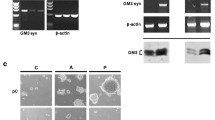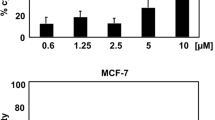Abstract
We evaluated the patterns of sialylation on fibrosarcoma cell lines arising following 3-methylcholanthrene treatments of wild-type and IL-1α-deficient mice; the former induced progressive tumors, whereas the latter cell lines induced regressing tumors or failed to develop into tumors in mice due to immune rejection. In regressing tumors, terminating α2-6-Neu5Ac residues were present at lower levels than in progressively growing tumors. In both tumor cells, the amount of α2-6-Neu5Ac residues was higher by an order of magnitude relative to the amount expressed in primary fibroblasts harvested from IL-1α-deficient and wild-type mice. We focused on membrane proteins, which may interact with the immune system. Interestingly, HSP65, grp75, and gp96 were found on the surfaces of malignant cells and were shown to possess sialylated N-glycans. The amount of trisialylated glycans on gp96 and HSP65 and monosialylated glycans on grp75 of regressing cells was significantly lower than in progressively growing cells, suggesting a dependency of these specific glycoforms on anti-tumor immunity.






Similar content being viewed by others
Abbreviations
- DDW:
-
double distilled water
- Gal:
-
galactose
- GlcNAc:
-
N-acetylglucosamine
- gp96:
-
96 kDa glycoprotein
- grp:
-
glucose regulated protein
- HPLC:
-
high performance liquid chromatography
- HSP:
-
heat shock protein
- IFN:
-
interferon
- IL-1:
-
interleukin 1
- Man:
-
mannose
- 3-MCA:
-
3-methylcholanthrene
- MHC:
-
major histocompatibility class
- Mw:
-
molecular weight
- Neu5Ac:
-
N-acetylneuraminic acid
- NK:
-
natural killer
- NKT:
-
natural killer T
- pI:
-
isoelectric point
- PNGase-F:
-
N-glycosidase F
- WT:
-
wild-type
References
Dube, D.H., Bertozzi, C.R.: Glycans in cancer and inflammation- potential for therapeutics and diagnostics. Nat. Rev. Drug Discov. 4, 477 (2005). doi:10.1038/nrd1751
Fuster, M.M., Esko, J.D.: The sweet and sour of cancer: glycans as novel therapeutic targets. Nat. Rev. Cancer. 5, 526 (2005). doi:10.1038/nrc1649
Dall’olio, F., Chiricolo, M., Altimari, A., Fiorentino, M., Grigioni, W.F.: Expression of β-galactoside sialyltransferase and of α2, 6-sialyltransferase glycoconjugates in normal human liver, hepatocarcinoma and cirrhosis. Glycobiol. 14, 39–49 (2004). doi:10.1093/glycob/cwh002
Dall’olio, F., Chiricolo, M.: Sialyltransferases in cancer. Glycoconj. 18, 841 (2001). doi:10.1023/A:1022288022969
Wang, P.H.: Altered glycosylation in cancer: sialic acids and sialyltransferases. J. Cancer Mol. 1, 73 (2005)
Seidenfaden, R., Krauter, A., Schretzinger, F., Gerardy-Schahn, R., Hildebrandt, H.: Polysialic acid directs tumor cell growth by controlling heterophilic neural cell adhesion molecule interactions. Mol. Cell. Biol. 23, 5908 (2003). doi:10.1128/MCB.23.16.5908-5918.2003
Swann, J.B., Smyth, M.J.: Immune surveillance of tumors. J. Clin. Invest. 117, 137 (2007). doi:10.1172/JCI31405
Dunn, G.P., Koabel, C.M., Schreiber, R.D.: Interferons, immunity and cancer immunoediting. Nat. Immunol. 6, 836 (2006). doi:10.1038/nri1961
Apte, R.N., Dotan, S., Elkabets, M., White, R.M., Reich, E., Carmi, Y., Son, X., Dvozkin, T., Kerlin, Y., Voronov, E.: The involvement of IL-1 in tumorigenesis, tumor invasiveness, metastasis and host-interaction. Cancer Metastasis. Rev. 25, 387 (2006). doi:10.1007/s10555-006-9004-4
Krelin, Y., Voronov, E., Dotan, S., Elkabets, M., Reich, E., Fogel, M., Huszar, M., Iwakura, Y., Segal, S., Dinarello, C.A., Apte, R.N.: IL-1 beta-driven inflammation promotes the development and invasiveness of chemical carcinogen-induced tumors. Cancer Res. 67, 1062 (2007). doi:10.1158/0008-5472.CAN-06-2956
Elkabets, M., Krelin, Y., Dotan, S., Cerwenka, A., Porgador, A., Lichtenstein, R.G., Dinarello, C.A., White, M.R., Zoller, M., Voronov, E., Apte, R.N.: Host-derived Interleukin-1α is important in determining the immunogenicity of 3-Methylcholantrene-tumor cells. J. Immunol. 182, 4874 (2009)
Gorelik, E., Xu, F., Henion, T., Anaraki, F., Galili, U.: Reduction of metastatic properties of BL6 melanoma cells expressing terminal fucose(alpha) 1–2-galactose after alpha1, 2-fucosyltransferase cDNA transfection. Cancer Res. 57, 332 (1997)
Shin, B.K., Wang, H., Yim, A.M., Le Naour, F., Brichory, F., Jang, J.H., Zhao, R., Puravs, E., Tra, J., Michael, C.W., Misek, D.E., Hanash, S.M.: Global profiling of the cell surface proteome of cancer cells uncovers an abundance of proteins with chaperone function. J. Biol. Chem. 278, 7607 (2003). doi:10.1074/jbc.M210455200
Küster, B., Wheeler, S.F., Hunter, P.A., Dwek, R.A., Harvey, D.J.: Sequencing of N-glycan oligosaccharides directly from protein gels: In gel deglycosylation and analyzing in HPLC and MALDI-TOF MS. Anal. Biochem. 250, 82 (1997). doi:10.1006/abio.1997.2199
Van Damme, E.J.M., Peumans, W.J., Pusztai, A., Bardocz, S.: Handbook of plant lectins: properties and biomedical applications, 1st edn. Willey, England (1998)
Tsuji, S., Datta, A.K., Paulson, J.C.: Systematic nomenclature for sialyltransferases. Glycobiol. 6, V (1996). doi:10.1093/glycob/6.7.647
Okajima, T., Fukumoto, S., Miyazaki, H., Ishida, H., Kiso, M., Furukawa, K., Urano, T., Furukawa, K.: Molecular cloning of a novel alpha2,3-sialyltransferase (ST3Gal VI) that sialylates type II lactosamine structures on glycoproteins and glycolipids. J. Biol. Chem. 274, 11479 (1999). doi:10.1074/jbc.274.17.11479
Sherman, M., Multhoff, G.: Heat shock proteins in cancer. Ann. N. Y. Acad. Sci. 1113, 192 (2007). doi:10.1196/annals.1391.030
Dunn, G.P., Bruce, A.T., Sheehan, K.C., Shankaran, V., Uppaluri, R., Bui, J.D., Diamond, M.S., Koebel, C.M., Arthur, C., White, J.M., Schreiber, R.D.: A critical function for type I interferons in cancer immunoediting. Nat. Immunol. 6, 722 (2005). doi:10.1038/ni1213
Dunn, G.P., Bruce, A.T., Ikeda, H., Old, L.J., Schreiber, R.D.: Cancer immunoediting: from immunosurveillance to tumor escape. Nat. Immunol. Rev. 2, 991 (2002)
Zitvogel, L., Tesniere, A., Kroemer, G.: Cancer despite immunosurveillance: immunoselection and immunosubversion. Nat. Immunol. Rev. 6, 715 (2006). doi:10.1038/nri1936
Hedlund, M., Ng, E., Varki, A., Varki, N.M.: Alpha 2-6-Linked sialic acids on N-glycans modulate carcinoma differentiation in vivo. Cancer Res. 68, 388 (2008). doi:10.1158/0008-5472.CAN-07-1340
Varki, N.M., Varki, A.: Diversity in cell surface sialic acid presentations: implications for biology and disease. Lab. Invest. 87, 851 (2007). doi:10.1038/labinvest.3700656
Rughetti, A., Pellicciotta, I., Biffoni, M., Bäckström, M., Link, T., Bennet, E.P., Clausen, H., Noll, T., Hansson, G.C., Burchell, J.M., Frati, L., Taylor-Papadimitriou, J., Nuti, M.: Recombinant tumor-associated MUC1 glycoprotein impairs the differentiation and function of dendritic cells. J. Immunol. 174, 7764 (2005)
Nicoll, G., Avril, T., Lock, K., Furukawa, K., Bovin, N., Crocker, P.R.: Ganglioside GD3 expression on target cells can modulate NK cell cytotoxicity via siglec-7-dependent and -independent mechanisms. Eur. J. Immunol. 33, 1642 (2003). doi:10.1002/eji.200323693
Lewis, M.J., Pelham, H.R.: Ligand-induced redistribution of a human KDEL receptor from the Golgi complex to endoplasmic reticulum. Cell. 68, 353 (1992). doi:10.1016/0092-8674(92)90476-S
Altmeyer, A., Maki, G.R., Feldweg, A.M., Heike, M., Protoprov, V.P., Masur, S.K., Srivastava, P.K.: Tumor-specific cell surface expression of the –KDEL containing, endoplasmatic reticular heat shock protein gp96. Int. J. Cancer. 69, 340 (1996). doi:10.1002/(SICI)1097-0215(19960822)69:4<340::AID-IJC18>3.0.CO;2-9
Multhoff, G.: Heat shock protein 70 (HSP70): membrane location, export and immunological relevance. Methods. 43, 229 (2007). doi:10.1016/j.ymeth.2007.06.006
Robert, J., Menoret, M., Cohen, N.: Cell surface expression of the endoplasmatic reticular heat shock protein gp96 is phylogenetically conserved. J. Immunol. 163, 4133 (1999)
Vega, V.L., Rodríguez-Silva, M., Frey, T., Gehrmann, M., Diaz, J.C., Steinem, C., Multhoff, G., Arispe, N., De Maio, A.: Hsp70 translocates into the plasma membrane after stress and is released into the extracellular environment in a membrane-associated form that activates macrophages. J. Immunol. 180, 4299 (2008)
Lee, A.S.: GRP78 induction in cancer: therapeutic and prognostic implications. Cancer Res. 67, 3496 (2007). doi:10.1158/0008-5472.CAN-07-0325
Srivastava, P.K.: Interaction of heat shock proteins with peptides and antigen presenting cells: chaperoning of the innate and adaptive immunity. Annu. Rev. Immunol. 20, 395 (2002). doi:10.1146/annurev.immunol.20.100301.064801
Broere, F.H., Weiten, L., Zee, R.V.D., Berlo, S.: Heat shock proteins induce T cell regulation of chronic inflammation. Ann. Rheum. Dis. 65, 65 (2007)
Doody, A.D.H., Kovalchin, T.J., Mihalyo, M.A., Hagymasi, A.T., Drake, C.G., Adler, A.J.: Glycoprotein 96 can chaperone both MHC class I- and class II-restricted epitopes for in vivo presentation, but selectively primes CD8 + T cell effector function. J. Immunol. 172, 6087 (2004)
Multhoff, G., Pfister, K., Gehrmann, M., Hantschel, M., Gross, C., Hafner, M., Hiddemann, W.: A 14-mer Hsp70 peptide stimulates natural killer (NK) cell activity. Cell Stress Chaperones. 6, 337 (2001). doi:10.1379/1466-1268(2001)006<0337:AMHPSN>2.0.CO;2
Dai, J., Liu, B., Caudill, M.M., Zheng, H., Qiao, Y., Podack, E.R., Li, Z.: Cell surface expression of heat shock protein gp96 enhances cross-presentation of cellular antigens and the generation of tumor-specific T cell memory. Cancer Immun. 3, 1 (2003)
Hwang, E.M., Kim, D.G., Lee, B.J., Choi, J., Kim, E., Park, N., Kang, D., Han, J., Choi, W.S., Hong, S.G., Park, J.Y.: Alternative splicing generates a novel non-secretable cytosolic isoform of NELL2. Biochem. Biophys. Res. Commun. 353, 805 (2006). doi:10.1016/j.bbrc.2006.12.115
Unoki, M., Shen, J.C., Zheng, Z.M., Harris, C.C.: Novel splice variants of ING4 and their possible roles in the regulation of cell growth and motility. J. Biol. Chem. 281, 34677 (2006). doi:10.1074/jbc.M606296200
Pyhtila, B., Zheng, T., Lager, P.J., Keene, J.D., Reedy, M.C., Nicchitta, C.V.: Signal sequence- and translation-independent mRNA localization to the endoplasmic reticulum. RNA. 14, 445 (2008). doi:10.1261/rna.721108
Varki, A.: Glycan-based interactions involving vertebrate sialic-acid-recognizing proteins. Nature. 443, 1023 (2007). doi:10.1038/nature05816
Suriano, R., Ghosh, S.K., Ashok, B.T., Mittelman, A., Chen, Y., Banerjee, A., Tiwari, R.K.: Differences in glycosylation patterns of heat shock protein, gp96: implications for prostate cancer prevention. Cancer Res. 65, 6466 (2005). doi:10.1158/0008-5472.CAN-04-4639
Guinez, C., Lemoine, J., Michalski, J.C., Lefebvre, T.: 70-Kda-heat shock protein presents an adjustable lectinic activity towards O-linked N-acethylglucosamine. Biochem. Biophys. Res. Commun. 319, 21 (2004). doi:10.1016/j.bbrc.2004.04.144
Yang, Y., Liu, B., Dai, J., Srivastava, P.K., Zammit, D.J., Lefrancois, L., Li, Z.: Heat shock protein gp96 is a master chaperone for toll-like receptors and is important in the innate function of macrophages. Immunity. 26, 1 (2007). doi:10.1016/j.immuni.2006.12.005
Dwek, R.A.: Glycobiology: toward understanding the function of sugars. Chem. Rev. 96, 683 (1996). doi:10.1021/cr940283b
Acknowledgements
The authors thank Dr. Uri Abdu for his help in carrying out fluorescent staining and microscopic imaging and Dr. Yoram Tekoah for helpful advice on glycan analysis by HPLC. This work was supported in part by the Israel Cancer Association and by the Israeli Glycobiology Center of Ben-Gurion University of the Negev, Israel.
Author information
Authors and Affiliations
Corresponding author
Additional information
This study is dedicated to the memory of Professor Shraga Segal
Electronic supplementary material
Below is the link to the electronic supplementary material.
Supplementary Table 1
List of proteins from membrane fraction of regressive and progressive fibrosarcoma cell lines developed in IL1α-/- and WT mice identified by MS-Tag search. (PDF 103 kb)
Supplementary Figure 1
Flow cytometry of regressive immunogenic and progressive fibrosarcoma cell lines derived from 3-MCA-injected IL-1α-/- and BALB/c mice before (left column) and after neuraminidase treatment (right column). Cells (6 × 106) were incubated with 10 mU of Arthrobacter ureafaciens neuraminidase, (EC 3.2.1.18, Calbiochem, San Diego, CA) in sodium phosphate buffer, pH = 6.0, for 1 h at 37°C, washed, divided into tubes, and then incubated similar to the untreated cells with varying fluorescent lectins, as described in Materials and Methods. (PDF 280 kb)
Supplementary Figure 2
Immunoblotting of EGFR using anti-mouse EGFR antibody at a concentration of 1 μg/ml per blot. EGFR was extracted from regressive immunogenic and progressive fibrosarcoma cell membranes using a ProteoExtract kit (Calbiochem, San Diego, CA). The immunoblotting of EGFR was performed as described for the immunoblotting of HSPs in the Materials and Methods section. (PDF 91 kb)
Supplementary Figure 3
Immunocytometry of HSP65 (a), grp75 (b), grp78 (c), and fluorescent staining for nuclei and actin in each set is shown. Cells (1 × 104) derived from either 3-MCA-induced fibrosarcoma cells injected into IL-1α-/- and BALB/c mice or from primary fibroblast cells derived from the skin of IL-1α-/- and BALB/c. (PDF 342 kb)
Rights and permissions
About this article
Cite this article
Avidan, A., Perlmutter, M., Tal, S. et al. Differences in the sialylation patterns of membrane stress proteins in chemical carcinogen-induced tumors developed in BALB/c and IL-1α deficient mice. Glycoconj J 26, 1181–1195 (2009). https://doi.org/10.1007/s10719-009-9238-9
Received:
Revised:
Accepted:
Published:
Issue Date:
DOI: https://doi.org/10.1007/s10719-009-9238-9




